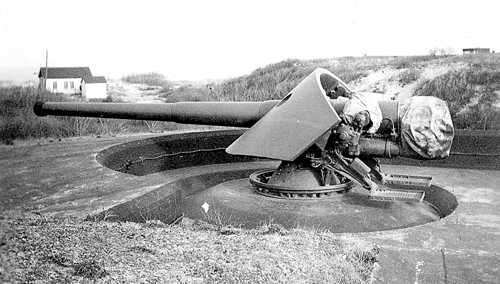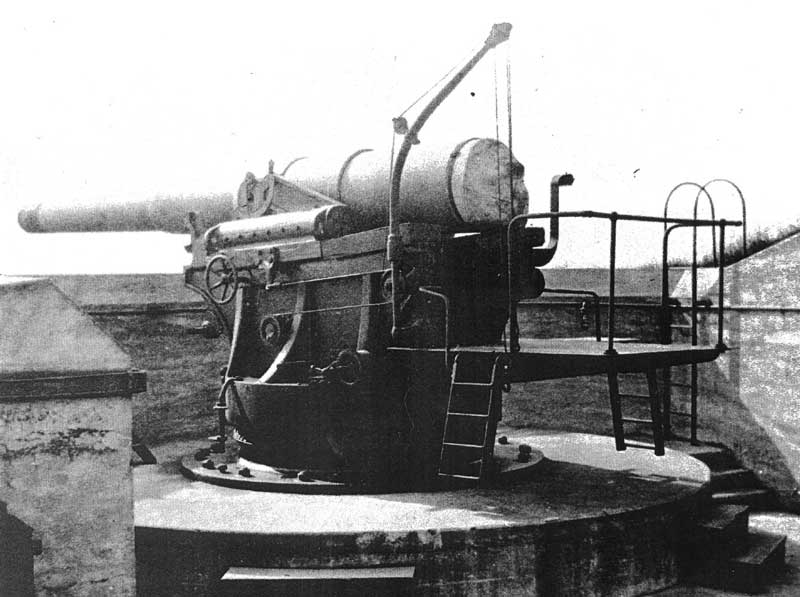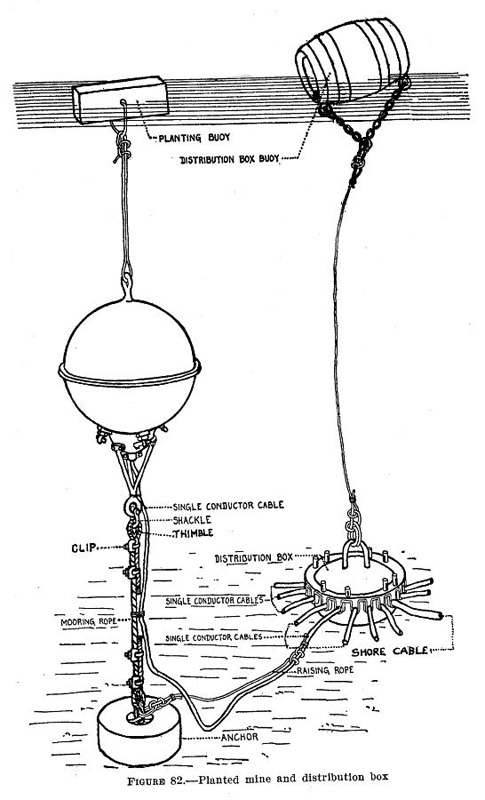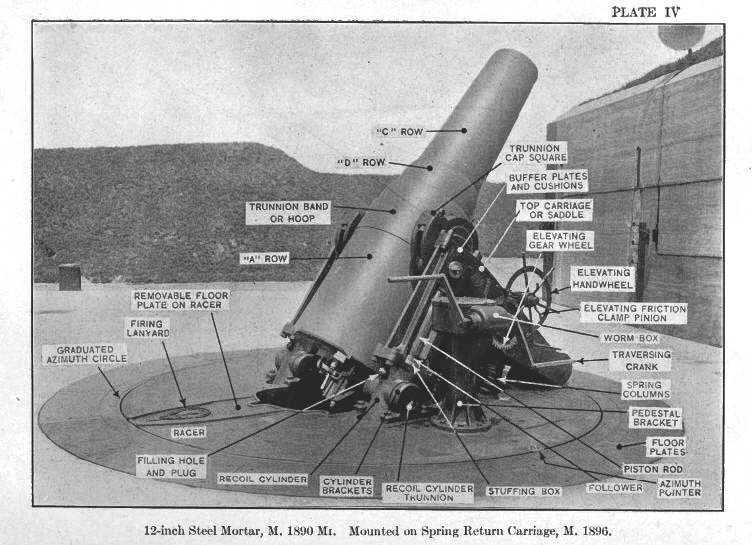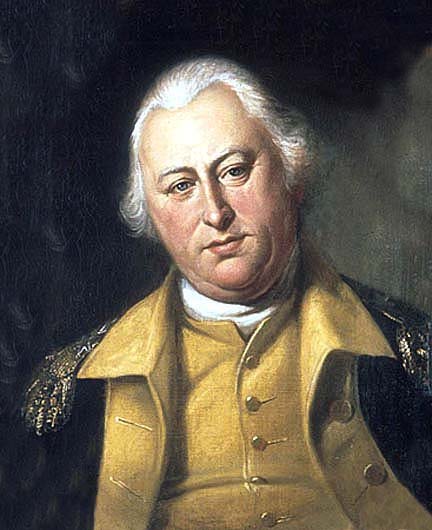|
6-inch Gun M1908
The 6-inch gun M1897 (152 mm) and its variants the M1900, M1903, M1905, M1908, and M1 (a.k.a. T2) were coastal artillery pieces installed to defend major American seaports between 1897 and 1945. For most of their history they were operated by the United States Army Coast Artillery Corps. They were installed on disappearing carriages or pedestal (a.k.a. barbette) mountings, and during World War II many were remounted on shielded barbette carriages. Most of the weapons not in the Philippines were scrapped within a few years after World War II. History In 1885, William C. Endicott, President Grover Cleveland's Secretary of War, was tasked with creating the Board of Fortifications to review seacoast defenses. The findings of the board illustrated a grim picture of existing defenses in its 1886 report and recommended a massive $127 million construction program of breech-loading cannons, mortars, floating batteries, and submarine mines for some 29 locations on the US coastli ... [...More Info...] [...Related Items...] OR: [Wikipedia] [Google] [Baidu] |
Battery Chamberlin
Battery Chamberlin is an artillery battery in the Presidio of San Francisco, San Francisco, California, United States. The battery is named in honor of Captain Lowell A. Chamberlin, who had served with distinction in the American Civil War, Civil War. It was added to the National Register of Historic Places on November 7, 1976. History This Endicott Board, Endicott-era battery was built in 1904 with four six-inch rifled guns mounted on disappearing gun, disappearing carriages and was intended to protect underwater naval mine, minefields laid outside the Golden Gate during the time of war. These guns had a maximum range of 7.5 miles, and crews were trained to fire two rounds per minute. The original guns were removed in 1917 for use in World War I. The battery received two six-inch guns on simple barbette carriages in 1920. During World War II, the Sixth Coast Artillery (Harbor Defense) Regiment, Battery "D", manned the two guns at Battery Chamberlin, living on-site until the en ... [...More Info...] [...Related Items...] OR: [Wikipedia] [Google] [Baidu] |
Philippines
The Philippines, officially the Republic of the Philippines, is an Archipelagic state, archipelagic country in Southeast Asia. Located in the western Pacific Ocean, it consists of List of islands of the Philippines, 7,641 islands, with a total area of roughly 300,000 square kilometers, which are broadly categorized in Island groups of the Philippines, three main geographical divisions from north to south: Luzon, Visayas, and Mindanao. With a population of over 110 million, it is the world's List of countries and dependencies by population, twelfth-most-populous country. The Philippines is bounded by the South China Sea to the west, the Philippine Sea to the east, and the Celebes Sea to the south. It shares maritime borders with Taiwan to the north, Japan to the northeast, Palau to the east and southeast, Indonesia to the south, Malaysia to the southwest, Vietnam to the west, and China to the northwest. It has Ethnic groups in the Philippines, diverse ethnicities and Culture o ... [...More Info...] [...Related Items...] OR: [Wikipedia] [Google] [Baidu] |
10-inch Gun M1895
The 10-inch Gun M1895 (254 mm) and its variants the M1888 and M1900 were large coastal artillery pieces installed to defend major American seaports between 1895 and 1945. For most of their history they were operated by the United States Army Coast Artillery Corps. Most were installed on Disappearing gun, disappearing carriages, with early installations on barbette mountings. All of the weapons not in the Philippines (except four guns in Canada) were scrapped during World War II. Two of the surviving weapons were relocated from the Philippines to Fort Casey in Washington (state), Washington state in the 1960s. History In 1885, William Crowninshield Endicott, William C. Endicott, President of the United States, President Grover Cleveland's Secretary of War, was tasked with creating the Board of Fortifications to review seacoast defenses. The findings of the board illustrated a grim picture of existing defenses in its 1886 report and recommended a $127 million construction p ... [...More Info...] [...Related Items...] OR: [Wikipedia] [Google] [Baidu] |
8-inch M1888
The 8-inch gun M1888 (203 mm) was a U.S. Army Coast Artillery Corps gun, initially deployed 1898–1908 in about 75 fixed emplacements, usually on a disappearing carriage. During World War I, 37 or 47 of these weapons (references vary) were removed from fixed emplacements or from storage to create a railway gun version, the 8-inch Gun M1888MIA1, Barbette carriage M1918 on railway car M1918MI, converted from the fixed coast defense mountings and used during World War I and World War II. History The M1888 gun was a coastal artillery gun initially deployed as part of the Endicott system of fortifications. The first nine were deployed on the M1892 barbette carriage in 1898, but the improved M1894 and M1896 disappearing carriages soon became available, and approximately 64 additional weapons were deployed on these carriages by 1908. An "emergency" converted Rodman carriage was also used during the Spanish–American War in 1898 to quickly arm 21 emplacements with the m ... [...More Info...] [...Related Items...] OR: [Wikipedia] [Google] [Baidu] |
Submarine Mines In United States Harbor Defense
The modern era of defending American harbors with controlled mines or Naval mine, submarine mines (originally referred to as "torpedoes") began in the post-Civil War period, and was a major part of US Seacoast defense in the United States, harbor defenses from circa 1900 to 1947. Brief history In 1866, the United States Army Corps of Engineers established the U.S. Army Engineer School, Engineer School of Application at Fort Totten (Queens), Willets Point, New York. The first commander of this school, Major Henry Larcom Abbot, was almost single-handedly responsible for designing and supervising the program of research and development that defined the strategy and tactics for the mine defense of American harbors. Abbot experimented with underwater explosives, fuzes, cabling, and electrical equipment for over a decade before publishing the first manuals on the use of mines in coast defense in 1876–77. At least one experimental controlled minefield was emplaced at this time, at Fort ... [...More Info...] [...Related Items...] OR: [Wikipedia] [Google] [Baidu] |
12-inch Coast Defense Mortar
The 12-inch coast defense mortar was a weapon of caliber emplaced during the 1890s and early 20th century to defend US harbors from seaborne attack. In 1886, when the Endicott Board set forth its initial plan for upgrading the coast defenses of the United States, it relied primarily on mortars, not guns, to defend American harbors. "Sea-Coast Mortar Fire", Report of a Board, in ''Journal of the United States Artillery'', Vol. 7, No. 3, 1897. Over the years, provision was made for fortifications that would mount some 476 of these weapons, although not all of these tubes were installed. Ninety-one of these weapons were remounted as railway artillery in 1918-1919, but this was too late to see action in World War I. The railway mortars were only deployed in small quantities, and none overseas. The fixed mortars in the Philippines saw action in the Imperial Japan, Japanese Philippines campaign (1941–1942), invasion in World War II. All of the fixed mortars (except four) in the Unit ... [...More Info...] [...Related Items...] OR: [Wikipedia] [Google] [Baidu] |
Board Of Fortifications
Several boards have been appointed by US presidents or Congress to evaluate the US defensive fortifications, primarily coastal defenses near strategically important harbors on the US shores, its territories, and its protectorates. Endicott Board In 1885, US President Grover Cleveland appointed a joint Army, Navy and civilian board, headed by Secretary of War William Crowninshield Endicott, known as the Board of Fortifications (now usually referred to simply as the Endicott Board). The findings of the Board in its 1886 report illustrated a grim picture of neglect of America's coast defenses and recommended a massive $127 million construction program for a series of new forts with breech-loading cannons, mortars, floating batteries, and submarine mines for some 29 locations on the US coast. Coast Artillery fortifications built between 1885 and 1905 are often referred to as Endicott Period fortifications. The first board consisted of the following officers and civilians: * Wi ... [...More Info...] [...Related Items...] OR: [Wikipedia] [Google] [Baidu] |
Secretary Of War
The secretary of war was a member of the U.S. president's Cabinet, beginning with George Washington's administration. A similar position, called either "Secretary at War" or "Secretary of War", had been appointed to serve the Congress of the Confederation under the Articles of Confederation between 1781 and 1789. Benjamin Lincoln and later Henry Knox held the position. When Washington was inaugurated as the first President under the Constitution, he appointed Knox to continue serving as Secretary of War. The secretary of war was the head of the War Department. At first, he was responsible for all military affairs, including naval affairs. In 1798, the secretary of the Navy was created by statute, and the scope of responsibility for this office was reduced to the affairs of the United States Army. From 1886 onward, the secretary of war was in the line of succession to the presidency, after the vice president of the United States, the Speaker of the House of Representative ... [...More Info...] [...Related Items...] OR: [Wikipedia] [Google] [Baidu] |
Grover Cleveland
Stephen Grover Cleveland (March 18, 1837June 24, 1908) was the 22nd and 24th president of the United States, serving from 1885 to 1889 and from 1893 to 1897. He was the first U.S. president to serve nonconsecutive terms and the first History of the Democratic Party (United States), Democrat elected president after the American Civil War, Civil War. Born in Caldwell, New Jersey, Cleveland was elected mayor of Buffalo in 1881 and governor of New York in 1882. While governor, he closely cooperated with New York State Assembly, state assembly minority leader Theodore Roosevelt to pass reform measures, winning national attention. He led the Bourbon Democrats, a pro-business movement opposed to History of tariffs in the United States#Civil War, high tariffs, free silver, inflation, imperialism, and subsidies to businesses, farmers, or Social history of soldiers and veterans in the United States, veterans. His crusade for political reform and fiscal conservatism made him an icon ... [...More Info...] [...Related Items...] OR: [Wikipedia] [Google] [Baidu] |
President Of The United States
The president of the United States (POTUS) is the head of state and head of government of the United States. The president directs the Federal government of the United States#Executive branch, executive branch of the Federal government of the United States, federal government and is the Powers of the president of the United States#Commander-in-chief, commander-in-chief of the United States Armed Forces. The power of the presidency has grown since the first president, George Washington, took office in 1789. While presidential power has ebbed and flowed over time, the presidency has played an increasing role in American political life since the beginning of the 20th century, carrying over into the 21st century with some expansions during the presidencies of Presidency of Franklin D. Roosevelt, Franklin D. Roosevelt and Presidency of George W. Bush, George W. Bush. In modern times, the president is one of the world's most powerful political figures and the leader of the world's ... [...More Info...] [...Related Items...] OR: [Wikipedia] [Google] [Baidu] |
William Crowninshield Endicott
William Crowninshield Endicott (November 19, 1826 – May 6, 1900) was an American politician and Secretary of War in the first administration of President Grover Cleveland (1885–1889). Early life Endicott was born in Salem, Massachusetts on November 19, 1826. He was a son of William Putnam Endicott and Mary (née Crowninshield) Endicott. He was a direct descendant of the Massachusetts governor, John Endecott, and a first cousin three times removed of another Massachusetts governor, Endicott Peabody. He graduated from Harvard University in 1847 and attended Harvard Law School in 1849–1850. He studied law with Nathaniel J. Lord prior to his admission to the Massachusetts bar in 1850. Career In 1852, he was elected a member of the Salem Common Council and, five years later, became City Solicitor. He was elected a member of the American Antiquarian Society in 1862. In 1853, he entered into a law partnership with J. W. Perry under the name Perry & Endicott, which was ... [...More Info...] [...Related Items...] OR: [Wikipedia] [Google] [Baidu] |
12-inch-DC-Annotated
1 (one, unit, unity) is a number, numeral, and glyph. It is the first and smallest positive integer of the infinite sequence of natural numbers. This fundamental property has led to its unique uses in other fields, ranging from science to sports, where it commonly denotes the first, leading, or top thing in a group. 1 is the unit of counting or measurement, a determiner for singular nouns, and a gender-neutral pronoun. Historically, the representation of 1 evolved from ancient Sumerian and Babylonian symbols to the modern Arabic numeral. In mathematics, 1 is the multiplicative identity, meaning that any number multiplied by 1 equals the same number. 1 is by convention not considered a prime number. In digital technology, 1 represents the "on" state in binary code, the foundation of computing. Philosophically, 1 symbolizes the ultimate reality or source of existence in various traditions. In mathematics The number 1 is the first natural number after 0. Each natural number, ... [...More Info...] [...Related Items...] OR: [Wikipedia] [Google] [Baidu] |
